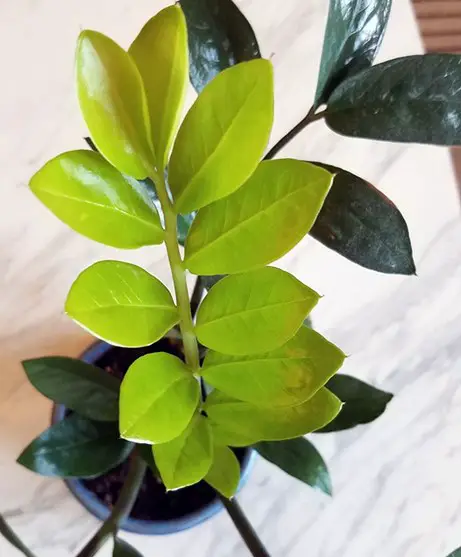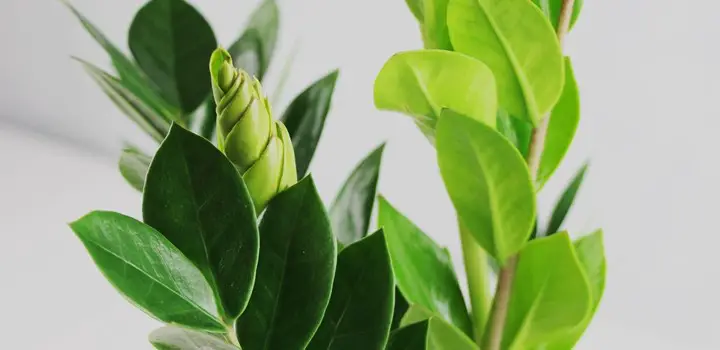The ZZ plant is known for its shiny foliage and uniform structure. If not taken care of properly, different issues arise which can eventually kill your plants. Light green foliage problems are common in such cases.
Improper watering, stress conditions, low light, nutrient deficiency, and pest problems may be the causes why your ZZ plant leaves turn light green.
Remember; Light green leaves are not that serious in the primary stage, but they can destroy your foliage over time. That’s why it’s necessary to control this issue as soon as possible.
So, if your glossy dark green leaves are losing their natural appearance, don’t worry! Here you will discuss the actionable solutions to revive your ZZ plant.
So, let’s get into the business without further ado.
What Causes Light Green Leaves In ZZ Plant [Treatments]

1. Improper Watering
Excessive and under watering both can be devastating for houseplants which gradually arise different problems in regular growth.
Well, most of the time there is common psychology among growers that more water means more vigor. But it’s not true all the time, especially in houseplants.
Too much water restricts oxygen in plant parts promoting stunted growth and light green leaves. As the ZZ plant is a slow grower, you may not be able to detect constricted growth. So, look for the latter one.
On the other hand, lack of water may also cause leaf discoloration. You may notice that your plant leaves are not shiny like before and they are drooping. It’s because of water deficiency for a prolonged time.
Now, let’s see how you can deal with these issues.
Control Measure
Generally, ZZ plants do not need heavy watering frequently. Applying water once a month is enough in winter. During the other seasons, you can follow a 12-15 days interval. But remember, base soil must be dried up before watering.
In general, overwatered plants recover within a week on their own. But hold on, providing a proper environment is important here.
You have to put your plant in direct sunlight for some time. Always allow water to drain through the drainage hole of your pot. Besides all these, keep checking the overall condition of your plant.
In case of insufficient watering conditions, it’s important to water the plant well. Make sure the roots receive a good amount of water.
2. Environmental Stress
Houseplants are quite susceptible to different weather conditions. Humidity, temperature, and sunlight can affect a lot in their growth cycle. Seasonal change in different climatic components can change the normal behavior pattern in your ZZ plants.
Excessive hot or cold weather and sudden change in the humidity can put your plants in stress conditions. In such a case your plant leaves may lose their natural color to paler green as there is reduced photosynthesis efficiency. If neglected, chlorosis may appear turning all your leaves yellow.
Even sometimes repotted plants may also show stress symptoms as they have issues in coping up with new soil media.
So, if you are noticing light green leaves in a new season, mark the surrounding changes. Here you need to work depending on your observations. Don’t worry, I am here to help. Keep reading.
Control Measure
ZZ plant ideal temperature is considered between 20°C to 25°C. During the winter season, it’s hard to maintain this range. Room heaters are an effective option here. Avoid freezing temperatures as much as possible.
Direct scorching sunlight can be harmful. So, do not allow them to be in mid-day sun for longer. If you already notice some wilting signs, put in enough water to recover.
ZZ plants can survive up to 30-40% humidity. So, use a humidifier to determine the one you are having in your room (our pick: AquaOasis Cool Mist Humidifier). Mist some water around your plant to bring up the level.
If your plant is in a stressed condition due to such changes, first of all, place them in a shady condition and water thoroughly.
You can also put some mulch at the base for some days. But don’t overdo this, as ZZ plants do not need much moisture. This method is only for stressed plants.
3. Low Light
ZZ plants are quite sensitive to light. According to their physiology, 8-10 hours of sunlight is necessary for them.
However, due to regional variation, you may not be able to provide prolonged lighting. In this case, plants show symptoms like wilting and discolored light green leaves.
Light is quite important for photosynthesis. Without enough sunlight, plant growth can be hampered and other issues like underdeveloped branches and leaves may arise.
So, let’s see how to adjust proper lighting to the ZZ plant.
Control Measure
For proper lighting, place your ZZ plant in such a corner where there is enough light throughout the day. Keep changing the position, as they can show phototropism if kept in a certain place for a longer time. This can disturb the straight growing pattern of your plant.
If you are growing in such a region where the day length is shorter, you may need to provide artificial lighting to your ZZ plant. LED lights are effective in this case.
Keep in mind that ZZ plants prefer indirect sunlight mostly. So, avoid mid-day scorching sunlight as much as possible. Otherwise, you may burn your foliage.
4. Nutrient Deficiency
Nutrient deficiency is a potential issue that can turn your foliage into a pale color. This issue is even more prominent in houseplants.
So, if you are wondering why the ZZ leaves are turning light green even after providing all the favorable conditions, the problems may be in your soil.
Nitrogen and Boron deficiency is considered to be the main reason behind leaf discoloration. So, let’s check what you can do to provide better nutrition to your plant.
Control Measure
Pick a balanced fertilizer that can provide all the necessary elements to your plant. Here is my suggestion- Aquatic Arts Indoor Plant Food
Phosphorus dose is needed to be reduced as these can hamper nutrient absorption. So, if you are putting any kind of organic manure, immediately stop using these.
You can also use some home remedies which can boost up the nutrient levels naturally. Here I have mentioned some-
#Recipe 1: Coffee Ground
Ingredients:
- Used coffee ground
- Fresh water
Steps:
- Wash the coffee ground with water
- Put them in your soil around the plant base
#Recipe 2: Grass Clippings
Ingredients:
- A gallon of grass clipping
- Fresh water
Steps:
- Fill a bucket with grass clippings and add water to this
- Keep this aside for 3 days
- Use the mixture to soil according to your need
5. Pest Infestation
Pests are the most annoying intruders in houseplants. Among the spider mites are the main culprits behind chlorosis. They suck up the chlorophyll leaving plant leaves pale in color. A light green leaf with dark green veins is a common symptom of chlorosis.
You may also notice some other pests like aphids, whiteflies, and so on. These are more devastating during the winter season.
Light green leaves with pale spots can indicate a pest attack. These spots may turn yellow to brown forming necrotic areas. So, it’s important to adopt the necessary measures to control such pests as soon as possible.
Control Measure
In the initial stage, water splashes work fine to remove pests and their residues. But if the infestation promotes, you may need to take a deep look into this matter.
Insecticidal soaps and oils are a good option in controlling garden pests. These are easily available in stores.
To control pests efficiently, pesticides can be used. Here I suggest you a milder dose suitable for houseplants(our pick: Bonide (BND951) – Systemic House Plant Insect Control)
You can also make some pest repellents on your own. Let me help you with this.
#Recipe: Homemade Insecticidal Spray
Ingredients:
- 2 tablespoons of vegetable oil.
- 2 tablespoons of liquid soap.
- 3 liters of water.
Steps:
- Mix vegetable oil and liquid soap in a container
- Slowly add water to this
- Transfer this solution into a spray bottle and apply to your plant
FAQs
Can I reverse leaf discoloration in the ZZ plant?
Light green leaves in the ZZ plant can be recovered with proper nutrient supply and with some care. But once it’s yellow, it’s gone. You have nothing to do with yellow leaves except wait to drop them off.
As you already know that pale green leaves are a preliminary sign of yellow leaves, so be careful with such an issue. Adapt the mentioned measures to tackle light green leaves immediately.
How can I keep my ZZ plant leaves dark green?
It’s a common question from the growers suffering from different foliage issues. Well, Magnesium supplements can help you in this. As Magnesium is the main component of chlorophyll, it will keep the pigment persistent in your ZZ plant.
You can use Epsom salt as a foliar spray to maintain bright green leaves. Just mix half a tablespoon of Epsom salt in 2 liters of water and spray this to your plant when new leaves are opening.
How do I know if my ZZ plant is healthy?
Your plant leaves can say a lot about your overall health. Bright green and glossy leaves are the common feature of the ZZ plant for which people pick it as a decorative indoor plant.
So, if your ZZ plant leaves are turning light green to yellow and brown with several burning issues, you may need to leap to attention. I have some articles on these leaf problems, you can check here.
Conclusion
In this article, I have tried to mention all the possible reasons with proper treatment by which you can deal with light green leaves in the ZZ plant. This may help you in getting back to those glossy leaves.
So, let’s sum up for the last time. All you need to do is maintain a proper watering schedule, provide favorable environmental conditions and nutrients and keep monitoring pests.
There’s nothing much to do, right? So what are you waiting for? Start treating your plant with proper care. Come back to my article if you need help in the future. Don’t forget to share your experience and queries in the comment section. Happy growing up.
